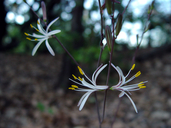Taxon Details
Chlorogalum grandiflorum
Red Hills soaproot
View Report Copy Link Calflora eFlora CCH CalPhotos iNaturalist
Taxon Summary:
Chlorogalum grandiflorum, commonly known as Red Hills soaproot, is a perennial bulbiferous herb in the Agavaceae that is found only in California. It occurs within Chaparral, Cismontane woodland, and Lower montane coniferous forest, growing at elevations from 245 to 1690 meters. Chlorogalum grandiflorum is ranked 4.2, Plants of Limited Distribution, A Watch List; Moderately threatened in California.|
Scientific Name: Chlorogalum grandiflorum Hoover |
||
|
Common Name: Red Hills soaproot |
||
| Family: | Agavaceae | |
| Element Code: | PMLIL0G020 | |
| USDA Plants Symbol: | CHGR3 | |
|
Synonyms/Other Names: |
||
| Name Status: |
JEF, FNA, POWO, IPNI, Tropicos |
|
| CA Rare Plant Rank: | 4.2 |
| Fed List: | None |
| State List: | None |
| Global Rank: | G3 |
|
State Rank: |
S3 |
| Other Status: | BLM_S; SB_SBBG |
|
CRPR Changes: changed from 1B.2 to 4.2 on 2025-06-24 |
|
| Add Date: | 1974-01-01 |
| Date Edited: | 2025-10-29 |
| Lifeform: perennial bulbiferous herb | ||||||||||||||
Blooming Period: (Apr)May-Jun
|
||||||||||||||
|
Elevation:
245 - 1690 meters 805 - 5545 feet |
||||||||||||||
General Habitats:
|
||||||||||||||
| Microhabitat Details: | ||||||||||||||
Microhabitat:
|
||||||||||||||
| Threat List Total: | 15 | |
| Total EOs | % of EOs | |
| EOs with Threat Listed: | 68 | 50 % |
| THREAT LIST: | ||
|---|---|---|
| Logging | 31 | 22% |
| Road/trail construction/maint. | 25 | 18% |
| Other | 17 | 12% |
| Development | 11 | 8% |
| Non-native plant impacts | 10 | 7% |
| ORV activity | 4 | 2% |
| Mining | 4 | 2% |
| Biocides | 4 | 2% |
| Grazing | 4 | 2% |
| Vandalism/dumping/litter | 3 | 2% |
| Wood cutting or brush clearing | 3 | 2% |
| Erosion/runoff | 2 | 1% |
| Foot traffic/trampling | 2 | 1% |
| Disking | 1 | 0% |
| Recreational use (non-ORV) | 1 | 0% |
| Total Occurrences: | 137 | ||||
| Element Occurrence Ranks: | |||||
|---|---|---|---|---|---|
| A | B | C | D | X | U |
| 7 | 41 | 19 | 5 | 0 | 65 |
| Occurrence Status: | |||||
|---|---|---|---|---|---|
| Historical >20 Years | 48 | ||||
| Recent <=20 Years | 89 | ||||
| Presence: | |||||
|---|---|---|---|---|---|
| Presumed Extant | 137 | ||||
| Possibly Extirpated | 0 | ||||
| Presumed Extirpated | 0 | ||||
| California Endemic: | |||||||||||||
| California Island: | |||||||||||||
|
States: Name (Code) California (CA) |
|||||||||||||
|
California Counties and Islands: Name (Code) Amador (AMA), Calaveras (CAL), El Dorado (ELD), Placer (PLA), Tuolumne (TUO) |
|||||||||||||
|
Quads: Name (Quad Code) Angels Camp (3812015), Aukum (3812056), Chinese Camp (3712074), Clarksville (3812161), Colfax (3912018), Coloma (3812078), Devil Peak (3812085), Devils Nose (3812044), Dorrington (3812033), Foresthill (3912017), Fort Mountain (3812034), Garden Valley (3812077), Garnet Hill (3812043), Georgetown (3812087), Greek Store (3912015), Greenwood (3812088), Michigan Bluff (3912016), New Melones Dam (3712085), Omo Ranch (3812055), Pilot Hill (3812171), Pine Grove (3812046), Pollock Pines (3812075), Rail Road Flat (3812035), Riverton (3812074), Robbs Peak (3812084), Salt Spring Valley (3812016), Shingle Springs (3812068), Slate Mtn. (3812076), Sonora (3712084), Tunnel Hill (3812086), West Point (3812045) |
|||||||||||||
Notes:
|
|||||||||||||
 Presumed Extant
Presumed Extant
Click on quad for name. Hold Shift Key to use mouse scroll wheel



